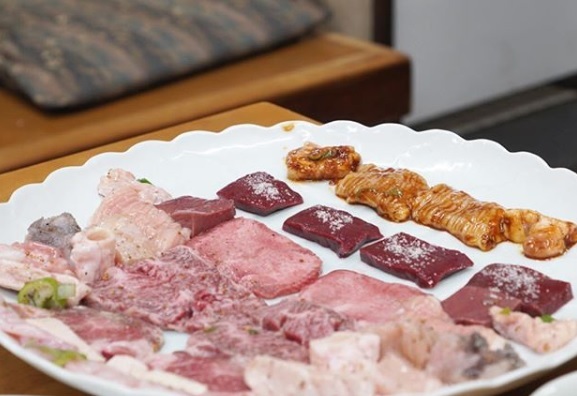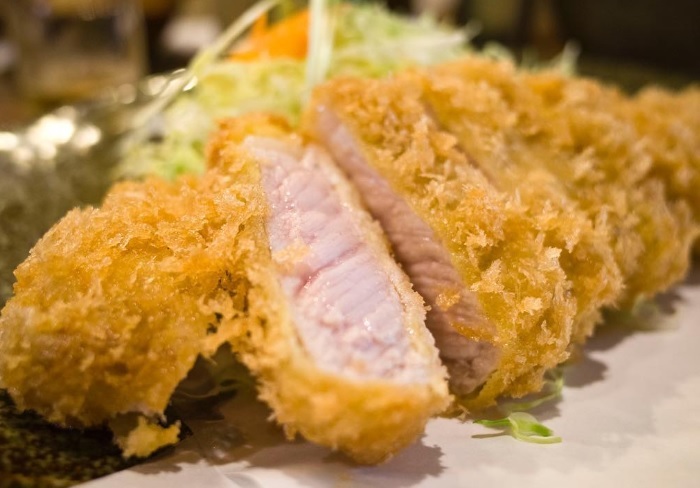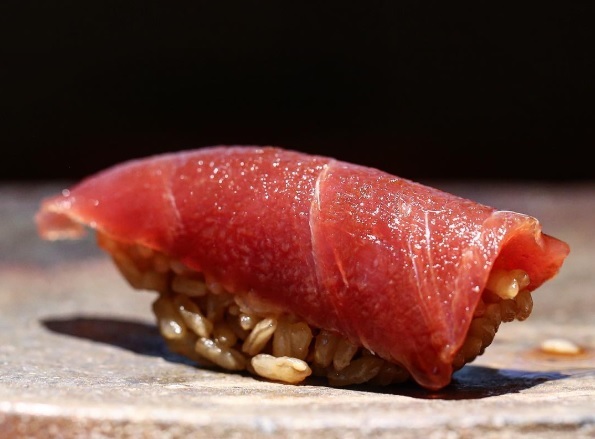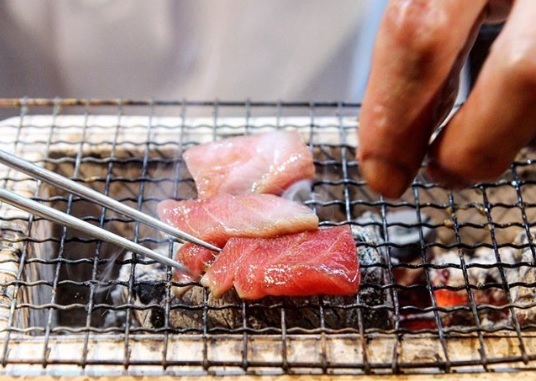What is "Edomae" ?
Nigiri sushi is also known as edomae sushi, but over the years there have been various theories of the meaning of the word "edomae," and there have also been a lot of misconceptions.
The word "edomae" refers to "the inlet in front of Edo Castle," and in the past, unagi (eel) caught there was called "edomae unagi."
Up until around 100 years ago, if a store had the word "edomae" written on its sign, it meant that the store sold unagi.
Rivers such as the Sumida River and Arakawa River flow into Edo Bay (now Tokyo Bay), which contains a lot of nutrients, and a lot of marine animals who feed on those nutrients.
Over time, the inlet in front of Edo Castle was filled in, and the original meaning of "edomae" ceased to exist, but the use of the word "edomae" to refer to seafood caught in Edo Bay would continue to spread.
Seafood not from Edo Bay was referred to with terms such as "tabi no mono" or "bachigai" ("out of place"), and clearly differentiated from edomae seafood.
In the Edo period, when nigiri sushi was first invented, the most pressing issue was how to preserve sushi ingredients for longer.
To preserve their food's freshness, they began to pickle "hikarimono" (sliced fish with the silver skin still on) such as kohada (spotted sardine) and aji (Japanese jack mackerel) in vinegar, and fish with white flesh were pickled in kombu or soy sauce as well as vinegar.
Even maguro (tuna) was pickled in soy sauce at the time, and known simply as "zuke" (literally "pickled"), which is a well-known fact among sushi aficionados.
Ingredients pickled in vinegar often tasted too sour, so in those cases, they put oboro (shiba shrimp that has been mashed, seasoned, and fried) in between the rice and the sushi ingredients, so that its sweetness would cancel out the sour flavor.
These tricks/techniques for preservation would be completely overhauled by the arrival of the refrigerator.
As you can tell by the very fact that sashimi is a type of cuisine, fresh fish is much more valuable than fish that isn't as fresh.
As refrigerators using ice evolved into electric refrigerators, and the roads and transportation systems improved in quality, many of the things that were done to sushi ingredients to preserve their freshness stopped being used.
By the 1980s, sushi was completely disconnected from the once necessary preservation techniques of the Edo period, and reached the height of its popularity.
However, ever since the gourmet boom of the 1990s, when people once again began to recognize the value of the work done by hand by sushi chefs,
this type of sushi has been known as sashimi sushi or fresh sushi, and treated separately from the traditional nigiri sushi.
As sushi returned to the ways of the Edo period, people started using the word "edomae," once used to describe the place where seafood was caught, to refer to sushi made the traditional way, or even the philosophy of creating sushi.
Classic Edomae Sushi Ingredient 1: Kohada
The kohada (spotted sardine), sometimes referred to as the champion of edomae sushi, is actually rarely seen outside of sushi.
The kohada is called by a few different names as it grows up, with its youth stage being known as "shinko."
As it matures, its name progressively changes from kohada, to nakazumi, to konoshiro.
Many say that samurai in the Edo period disliked konoshiro because in Japanese, the phrase "eat konoshiro" sounds the same as "eat this castle," so as a result kohada became more popular than konoshiro.
Fishermen with kohada to sell can be found in markets throughout Japan all year round, so you can eat it any time at a sushi restaurant, but they're truly in season from winter through to spring.
Supposedly, in the past people would get enought kohada for a year during this time, remove the organs, put them in a pot, and pickle them in vinegar and salt before closing the lid and storing them under the floor.
They still pickle it in salt and vinegar today, but there is now a process called "furishio" that involves sprinkling just the right amount of salt onto an opened kohada; this is a complex artisanal task requiring a lot of experience.
Strictly speaking, the correct amount of salt for each kohada is different, so sprinkling the right amount of salt on each kohada when they're all lined up together requires years of experience and a master's intuition.
After the furishio process, the kohada is left out for a while, but the length of this time also varies between summer and winter.
The salt is then washed off with water, and after the water is dried off, the fish is pickled in vinegar.
This kohada preparation process takes a huge amount of work, but also varies from restaurant to restaurant.
This variance reflects the individual chef's vision of the perfect kohada, which is why kohada is said to be the face of a restaurant.
Classic Edomae Sushi Ingredient 2: Hamaguri
While hamaguri (common Orient clam) is one of the most iconic edomae sushi ingredients, if you ask for it at a sushi restaurant, many of them will start to mumble, before you eventually find out they don't serve it at all.
But conversely, that means that the presence (or absence) of hamaguri on an edomae sushi restaurant's menu is a convenient yardstick for measuring the restaurant's potential.
As you can tell from the fact that hamaguri as a sushi ingredient is also known as "boiled hamaguri," the clam is boiled during preparation.
However, when hamaguri is boiled, it gets hard, and you can't taste the harmony between that delicious shellfish flavor that oozes out from its soft flesh and the sweetness of the tsume.
That's why, in the edomae preparation method, you first wash the skinned fish in a stream to get rid of the sand and slime on it, then put it in boiled water and heating it for a short time, before thoroughly removing the internal organs and tendons and opening it up with a knife.
You then pickle it in tsume, which is made of hamaguri broth, sugar, soy sauce, and mirin (sweet rice wine) all boiled together.
So the real meaning is "pickled hamaguri," but traditionally it has always been known as "boiled hamaguri."
This is one of the most time consuming things to prepare in edomae sushi, and it's harder to come by high quality hamaguri than it was in the old days, which are two of the possible reasons we're now seeing more sushi restaurants that don't serve boiled hamaguri.
Classic Sushi Ingredient 3: Anago
Anago (conger eel) is prepared by boiling it with soy sauce, mirin, sugar, etc. By boiling down the leftover broth with ingredients like sugar and mirin, restaurants create their own unique "tsume."
They say it's essential to stir it with a paintbrush while boiling so it doesn't burn.
Most of the time, anago is a slightly brown color, but there's also an edomae boiling technique called "sawani," where you either use light soy sauce, or don't use soy sauce and mirin at all, and cook it in just sake and white sugar, making the anago white.
Alongside maguro and kohada, anago is one of the most iconic edomae sushi ingredients, and every restaurant has their own secret tsume recipe.
That makes this the ingredient that most reveals the differences in style between restaurants.
Anago is usually served with tsume, but in recent years some stores have stopped using tsume, opting instead to sprinkle salt on it.
By the way, in the traditional way of making anago sushi, the top half of the eel is prepared skin side up, while the bottom half is prepared skin side down, so many restaurants recommend ordering two pieces so you can taste both versions.
Register account first.
Register










Comments 2
2
Wanderlusting
This is such a good article, the comments are also superb. Thank you for sharing so much knowledge in English, which is so hard to find online.
Leo Saito
chief editor, TokyoTableTripI'm going to explain the meaning of the word "edomae," something that seems like it's common knowledge but is surprisingly unknown.